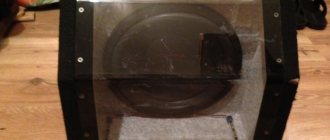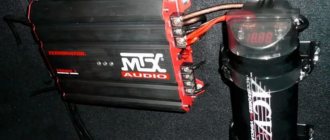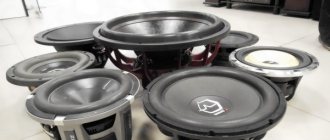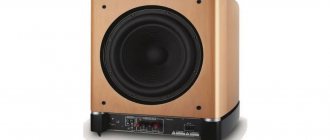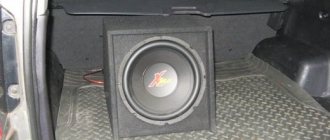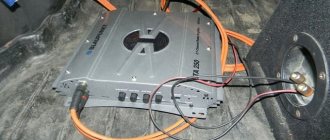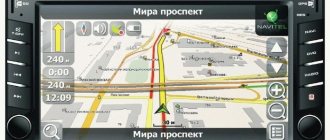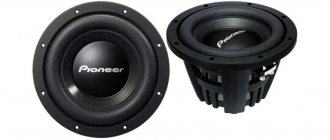Active sub in the car
Typically, car radios have poor low-frequency output. Therefore, connecting an active subwoofer to a car is an important process if there is a need to improve the car's acoustics. With the help of an active subwoofer, you can easily create high-quality speakers in the car interior, despite limited space. In this article we will learn how to connect an active subwoofer in a car easily and simply.
Note. Note that the correct operation of a subwoofer implies not only its purchase and further installation, but also its proper connection to the car.
Types of devices
There are two types of subwoofers:
- Active. An active subwoofer is a full-fledged acoustic system, which includes a speaker in the housing and a built-in power amplifier. Almost all models of compact active subwoofers use 8-inch speakers. Standard devices are most often produced in standard sizes of 10 and 12 inches. Prices for such devices range from 3 to 12 thousand rubles.
An active subwoofer looks like a big cylinder - Passive. This category has a fairly large selection of subwoofers, the differences of which lie in their characteristics and designs. The usual speaker sizes in this segment are 10 and 12 inches. The cost of such devices is from 2 to 40 thousand rubles, and in the last price category the most powerful subwoofers are usually presented, having two speakers at once.
Passive subwoofer resembles a hexagonal prism
The main differences between active and passive subwoofers:
- An active subwoofer has a built-in amplifier, while a passive subwoofer must be connected to external sound amplifiers.
- An active subwoofer is easier and faster to set up.
- If the system is configured with maximum precision and of sufficient quality, then the passive subwoofer produces a more voluminous and dense sound. It is rare to achieve the same effect with an active system.
Speaker selection
Although in theory a sub can be made from a regular home speaker, which is used in music centers or on computers, to achieve a good result I advise you to choose the speaker responsibly.
Using one compact element or trying to assemble a system of two speakers, this directly affects the size of the box, as well as the frequency spectrum that the device can reproduce.
There are several main speaker options:
Design features of devices
To understand what parameters to use to choose a subwoofer for your car, you need to thoroughly understand how it works. By design, subwoofers are divided into four types:
- Closed, with a sealed housing. The subwoofer is mounted in a box of a given volume. It dampens the closed sound wave behind the speaker. However, devices with a closed design are not the best subwoofers for cars. They are rarely used due to low efficiency. A closed subwoofer box extinguishes a closed sound wave
- Bass reflex. These are closed boxes with a tunnel (bass reflex) of a certain size. Thanks to the tunnel, increased pressure is created on the speaker used, which allows you to raise the sound level at a given frequency in the range from 50 to 120 Hz. The enclosed space increases the pressure exerted on the cone, which reduces the likelihood of sound distortion. The occurrence of mechanical damage to the speaker is also excluded.
In this case, the phase inverter corrects the rise in the frequency response (amplitude-frequency characteristic) and relieves the diffuser from excess pressure. All this leads to a significant increase in the efficiency of the subwoofer. Bass reflex box reduces sound distortion - Stripes. These are subwoofers with speakers tucked inside. The most complex type of device, it requires additional space. This is explained by the need to combine the features inherent in the closed-type design and the bass reflex. The basis for the product is a box with a bass reflex tunnel. A speaker is installed inside, which also acts as a partition. Thanks to this design, there is a closed, sealed space behind the speaker, which adds rigidity to the cone. A volumetric compartment is formed in front of the speaker, which has an output due to the presence of a bass reflex.
Subwoofer bandpass requires additional space - Subwoofers with a passive radiator, having a second passive speaker designed to reduce the resonant frequency. The installation of such systems is practiced in E-class cars (for example, Mercedes-Benz E-class).
Passive subwoofer driver reduces resonant frequency
The main advantages of using closed subwoofers in cars:
- simple calculations of the volume of the structure;
- low probability of speaker overload;
- high level of low frequency reproduction.
Adjustments
In addition to a large speaker (8-15 and even up to 21 inches), the subwoofer housing contains an amplifier and a signal processing unit: volume control, upper cutoff frequency, as well as a switch or smooth phase shift adjustment. The most logical and understandable adjustment for an untrained person is volume, which allows you to set a comfortable bass level in the room.
This is what a good subwoofer speaker looks like.
To adjust the cutoff frequency, you already need to know the frequency characteristics of your speaker system and the settings in the amplifier or receiver, if provided. This parameter allows you to obtain a uniform transition from the lower boundary of the sound of the main speakers to the subwoofer. As a result, we do not hear a dip, or, conversely, a significant increase in sound volume in the so-called “upper bass” or “lower mid” ranges. Please note that budget subwoofer models often do not have adjustment for this parameter, which means that it will be difficult to pair them with the acoustics in a stereo system, since, unlike AV receivers for home theater, most stereo amplifiers do not have corresponding adjustment.
Adjustment panel of a well-equipped subwoofer
Adjusting the phase shift is necessary so that the subwoofer and the main speaker do not have time differences. For example, if the subwoofer is located quite far from the speakers, then its sound may be delayed. To avoid this, phase shift correction is used.
Expensive subwoofers are sometimes equipped with a remote control, with which it is convenient to adjust their characteristics, controlling the sound in real time, what is called - without leaving the couch - REL G2.
Elegant remote control for the REL G2 subwoofer
There are subwoofers with very advanced electronic tuning circuits, including room acoustic correction systems based on a digital processor and the ability to control all their characteristics using an iOS or Android tablet or smartphone. An example of such a subwoofer is the ELAC SUB 2050 model.
This is what the control interface of the ELAC SUB 2050 subwoofer looks like
Specifications
When purchasing a subwoofer, you should pay attention to the following characteristics:
- peak power (W). It is with the help of peak (maximum) power that buyers are attracted. After all, car owners first of all want to know whether the system can “rock” the car with bass in order to attract the attention of others. Peak loads indicate at what level the speaker can operate most efficiently. Most often, they are approximately 3 times higher than the indicators that are optimal for long-term operation, however, devices with such characteristics are often at the very top of the rating of subwoofers for cars;
Table showing the dependence of the peak powers of subwoofers on the volume of the premises - rated power (W). The manufacturer tries not to focus on the rated power - this indicator is not as impressive as the previous one. But it is this information that tells the buyer what level of sound the selected speaker can produce without distortion. At the same time, it can operate at higher powers in optimal mode. Most car enthusiasts who decide to purchase a subwoofer are not looking for high power. Therefore, the optimal devices are those for which this indicator ranges from 200 to 300 W;
By the way, for expensive high-quality speakers there is no significant difference between peak and nominal loads, which cannot be said about cheap models. This is explained by the fact that a high-quality speaker has the ability to reproduce high-quality bass even at very high powers. This means that its rated loads are close to peak values. At the same time, the peak power of inexpensive speakers can be even higher than that of higher quality speakers. However, the rated power will certainly be lower.
- sensitivity (dB). The speaker's sensitivity determines its volume. However, we should not forget about the negative impact of volume on sound quality;
- range of reproduced frequencies (Hz). The frequency range of speakers used in subwoofers ranges from 20 to 200 Hz. The depth of bass that interests the car owner directly depends on what the lower value is. In addition, the housing used to house the speaker and the volume in which it is located are of great importance. It is these indicators that determine how the subwoofer will reproduce certain frequencies;
The diameter of the subwoofer diffuser is an important technical characteristic - diffuser diameter (inches). Another important parameter is the diameter of the diffuser. This is what many users associate with the power of a subwoofer. The most popular sizes are 8”, 10”, 12”, 15”. True, one cannot deny the presence of some scatter to a lesser or greater extent. The presence of a small diffuser means that the power of the bass output will not be very high.
There are sizes that are recognized as optimal, that is, they allow you to produce a sound that suits the majority of car owners. So, 10” is the best option for those who like not very powerful bass, and 12” is for those who like it “hot”.
Selection options
If you want to buy a thin or cabinet-mounted high-quality subwoofer, you should consider certain parameters when purchasing:
- First you need to decide on the type of acoustics used in the car. If the car uses simple speakers with an amplifier, then buying a sub is not necessary. According to many experts in the field of car audio, the use of subwoofers is relevant only when the speakers and car radio reproduce high-quality sound. If you have inexpensive speakers and a cheap Chinese radio, there is no point in installing such a device - there will be no results anyway.
- One of the most important parameters is the type of device. As stated above, it can be active or passive. It should be noted that in the case of active devices, installation will be simpler; you will just need to connect the device to the existing acoustics. In practice, active devices produce a rougher sound, since their assembly, as a rule, uses lower quality parts. The use of passive type devices is relevant if a high-quality amplifier is used in the acoustics.
- Dimensions. If you think that flat subwoofers play less well, and larger devices produce more powerful sound, then you are mistaken. Devices with larger dimensions produce more noise due to vibrations. As practice shows, the best option would be to purchase a device measuring 10-12 inches.
- What the product is made of, in particular, we are talking specifically about the suspension. The modern car audio market offers consumers a large selection of devices in which the suspension is made of rubber. But you need to take into account that this material makes the sound itself harder. If you want the sound to be soft, then it is better to give preference to devices with a rubber suspension.
- Another parameter is power.
The design of the subwoofer is unimportant, just like the characteristics that are indicated on the packaging. Most manufacturers purposefully inflate the parameters of the product, which are applied to the packaging, but this is only a marketing ploy. We also recommend not even considering products from unknown manufacturers, in particular if their cost is suspiciously low. If you have decided on a model, then before purchasing you should also read the reviews of other consumers - often the comments tell more than the official data about the product. The video below describes in detail the procedure for making a subwoofer yourself (the author of the video is Denis Legostaev).
How to choose the right subwoofer for your car
In order for the selected subwoofer to sound high quality and look organically in the interior of the cabin, it is enough to follow a few rules:
- The power characteristics of the subwoofer must match the operating parameters of the low-frequency amplifier. In this case, it is necessary to take into account all output channels of the amplifier. That is, if it has 3 channels with a power of 100 W each, then the subwoofer should have at least 400 W. In addition, both rated and peak power must be taken into account.
- The equivalent volume of the subwoofer is calculated taking into account the power of the speakers. However, the car interior has volume limitations, which means that before purchasing speakers it is necessary to calculate their maximum allowable dimensions. It is also very important to choose the right location for installing the device.
- When choosing the type of subwoofer, you should take into account the desired level of sound quality and the parameters of the head unit. If it has enough power to drive it, a passive speaker system can be used. If the power is not enough, it is recommended to use active options, or you will have to use an additional amplifier.
How to make a do-it-yourself subwoofer box for a car
A stealth subwoofer is perfect for a car. It is compact and invisible, which makes this model ideal for a car. A good speaker will require at least eighteen liters of volume. The placement problem can be solved by moving the front panel into the trunk or using a niche for a spare wheel.
We recommend:
How to choose a navigator for a car: review of the best
During installation, the front panel extends and connects to the trunk trim. The latter is cut along the junction line of the amplifiers and subwoofer. Then the surface is masked where it comes into contact with the polyester resin. The form can be made from corrugated cardboard. You can glue the parts together with tape. The metal frame is assembled with orientation towards the edge of the fiberglass. The latter is used to make the amplifier cladding panel. Between the parts there should be a thickness equal to the rest. Fiberglass and putty will help give the device a more presentable appearance.
Column installation
Location of the subwoofer in the cabin
For proper operation of the subwoofer, it must be installed taking into account the specific body type:
- In station wagon cars, the subwoofer should be directed with the bass reflex and speaker towards the rear of the car.
- If the body is a hatchback, it is best to position the device so that it is directed towards the roof of the car or the trunk door. If directed towards the back of the seat, loss of sound quality may occur.
- The sedan body assumes that the subwoofers are directed towards the rear seat. In this case, the gap between the subwoofer and the seat should be at least 8 cm.
Installation
The human hearing aid is designed in such a way that it is not sensitive to the direction of low frequencies; they do not have a clear localization in the room. And this frees our hands when installing a subwoofer. You can choose almost any corner in the room for it. However, there are a few rules to follow.
First, the subwoofer must be placed on a flat, solid surface. Remember that this device is subject to significant vibrations, which can negatively affect the sound and also damage the subwoofer itself.
The installation site itself should be at some distance from walls and furniture. Particular close attention should be paid to the bass reflex (if available), the “pipe” of which should not be closer than 20-30 centimeters to any surface. It is not advisable to place the subwoofer near capacious cabinets, glass structures, or dish display cases. All of them are an excellent source of resonances. They will add their own overtones to the sound, which you probably won’t want to hear while enjoying your favorite recordings. For the same reason, you should not place or place any objects on the body. It is very tempting to use this wooden cube as an additional table. But, believe me, placing a remote control on it will not be able to improve the sound picture, even if it tries very hard.
The third condition is the availability of a power outlet and the ability to conveniently lay the signal cable. The subwoofer amplifier requires electrical energy, but you should not pull a simple cheap extension cord to it, reducing the quality of the supplied energy. In addition, it does not look aesthetically pleasing and significantly reduces ergonomics. Who likes to regularly trip or get tangled in wires? It is better to install the subwoofer near a separate outlet or take care of connecting stationary electricity to the desired point in the room.

